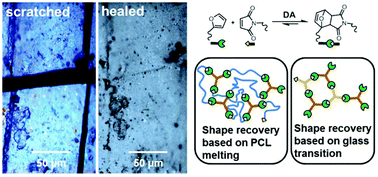Healable shape memory (thio)urethane thermosets†
Abstract
Urethane–thiourethane networks combining shape memory properties and the ability to self-heal under mild temperature conditions via Diels–Alder (DA) chemistry were developed. As a result of the shape recovery effect, no external force was needed to bring the fracture surfaces into intimate contact during the healing process. Four network architectures with DA net-points were evaluated. Two systems were composed of either bismaleimidic or bisfuranic semi-crystallized polycaprolactone chains acting as shape memory switching segments (Ttrans = Tm), whereas the other two networks consisted of bis-/trismaleimidic and trisfuranic monomers and displayed glass transitions for initiating shape recovery behaviour (Ttrans = Tg). The formation of the DA cross-links, the DA reversibility and shape memory assisted scratch healing of the materials were studied by FTIR and 1H-NMR spectrometry, differential scanning calorimetry, optical microscopy and tensile measurements. The results indicated that the healing efficiency of scratches depends strongly on the shape recovery ability, without which crack closure and thus the healing reaction could not occur. Two materials were found to feature good shape memory properties as well as efficient scratch-healing capacities, showing mechanical recoveries of 70–80% and the almost complete disappearance of scratches after healing at a mild temperature of 60 °C for 1–3 days. These materials could find applications in diverse fields such as self-healing coatings.


 Please wait while we load your content...
Please wait while we load your content...